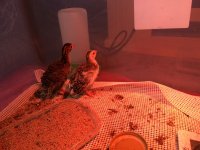- Mar 5, 2014
- 136
- 4
- 73
Full pearling and gray are dominant genes. Lavenders are blue based which is recessive and they are fully pearled which is dominant. Barring any hidden recessive genes in either the pearl gray or the lavender the results will be all pearl grays. It doesn't matter which is the hen and which is the cock the results will be the same as long as there aren't any hidden recessive genes.
If there are hidden recessive genes, then most anything can happen.
I see. Thanks!








